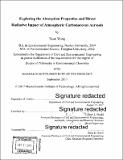| dc.contributor.advisor | Colette L. Heald. | en_US |
| dc.contributor.author | Wang, Xuan, Ph. D. Massachusetts Institute of Technology | en_US |
| dc.contributor.other | Massachusetts Institute of Technology. Department of Civil and Environmental Engineering. | en_US |
| dc.date.accessioned | 2018-02-08T16:26:20Z | |
| dc.date.available | 2018-02-08T16:26:20Z | |
| dc.date.copyright | 2017 | en_US |
| dc.date.issued | 2017 | en_US |
| dc.identifier.uri | http://hdl.handle.net/1721.1/113493 | |
| dc.description | Thesis: Ph. D. in Environmental Chemistry, Massachusetts Institute of Technology, Department of Civil and Environmental Engineering, 2017. | en_US |
| dc.description | Cataloged from PDF version of thesis. | en_US |
| dc.description | Includes bibliographical references (pages 125-141). | en_US |
| dc.description.abstract | Atmospheric aerosols are important due to their adverse effects on human health and their direct and indirect radiative effects on climate, which are significant and very uncertain factors contributing to global climate change. In estimating the direct radiative effect (DRE), the absorption from carbonaceous aerosols, including black carbon (BC) and brown carbon (BrC, a component of organic aerosol, OA), are highly uncertain. This thesis addresses this uncertainty by combining models and observations to better constrain the optical properties and radiative impact of carbonaceous aerosols. First, a global model simulation (GEOS-Chem) of BC is expanded to separately treat both the aging and physical properties of BC from different sources. By combining model and observations, the global BC lifetime is found to be overestimated in previous investigations, leading to higher estimates of its warming potential. The DRE of BC is estimated to be less than one quarter of the previously reported value. Second, a new method is developed to derive BrC absorption from measurements and used to identify BrC from total absorption observations. The absorption efficiency of BrC is found to be positively correlated with the emitted BC/OA mass ratio, which is related to combustion conditions. In addition, measured BrC absorption from biomass burning plumes is found to decrease with photochemical aging with a lifetime of one day. Third, a global model simulation of BrC is developed and tested against BrC absorption measurements from aircraft campaigns in the continental United States. The BrC absorption properties from biomass burning estimated based on laboratory measurements are found to overestimate the direct measurements of ambient BrC absorption. In addition, applying a photochemical aging scheme for BrC improves the model skill. The simulation suggests that the DRE of BrC has been overestimated previously due to the lack of observational constraints from direct measurements and omission of the effects of photochemical aging. Finally, the influence of mixing state on the global absorption of carbonaceous aerosols is estimated through simplified model experiments. This thesis suggests that policies for reducing emissions of carbonaceous aerosols may have a limited impact on mitigating global climate warming. | en_US |
| dc.description.statementofresponsibility | by Xuan Wang. | en_US |
| dc.format.extent | 141 pages | en_US |
| dc.language.iso | eng | en_US |
| dc.publisher | Massachusetts Institute of Technology | en_US |
| dc.rights | MIT theses are protected by copyright. They may be viewed, downloaded, or printed from this source but further reproduction or distribution in any format is prohibited without written permission. | en_US |
| dc.rights.uri | http://dspace.mit.edu/handle/1721.1/7582 | en_US |
| dc.subject | Civil and Environmental Engineering. | en_US |
| dc.title | Exploring the absorption properties and direct radiative impact of atmospheric carbonaceous aerosols | en_US |
| dc.type | Thesis | en_US |
| dc.description.degree | Ph. D. in Environmental Chemistry | en_US |
| dc.contributor.department | Massachusetts Institute of Technology. Department of Civil and Environmental Engineering | |
| dc.identifier.oclc | 1020068313 | en_US |
